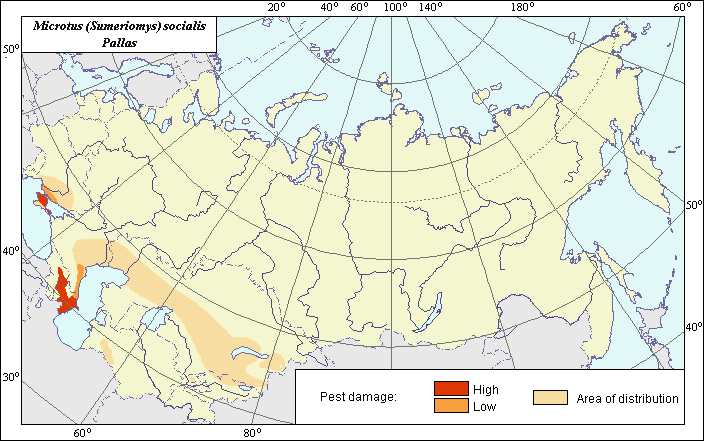Pests
The distribution and zones of harmfulness of the European Social vole (Meadow mouse) Microtus (Sumeriomys) socialis (Pallas, 1770).
 Object description Download GIS-layers
Object description Download GIS-layers
Authors:
specialist-biologist F.A. Karlik, GIS-specialist M.I. Saulich.Date of creation:
20.04.2003.Scale:
1:20 000 000.Accuracy of map:
Map was created based on materials of maps of natural scale 1:12 000 000.Projection:
"Alber.s Equal Area Conic", 9, 1001, 7, 100, 0, 44, 68, 0, 0.Basic contents:
Vector map. Area of species distribution is shown by polygons. Zones of recorded mass outbreak are shown by polygons.Accuracy of classifier:
Depending on economic significance, the area was divided into zones of strong (stable) and moderate (unstable) harmfulness. Periodicity of rising pest populations and mass outbreaks was used to determine the boundary of each zone. In the zone of strong (stable) harm, rising populations and mass outbreaks were registered at least every 2nd-3rd year and in the zone of moderate (unstable) harm, approximately every 5th year.Method of map production:
Scientists were given maps with boundaries of Oblasts and arable lands. After reviewing historic literature, species distribution was hand drawn on maps. If data were on the Oblast-level, distribution is on the Oblast level. In some cases, Oblast.s are further refined by boundaries of the Arable Land Map (Koroljeva et al., 2003). Hand drawn maps were scanned, georeferenced and vectorized. Zones of harmfulness were determined according to the methodical guidelines of the All Russian Institute of Plant Protection (1985).Reference citations:
All Russian Institute of Plant Industry. 1975. Methodical guideline: Distribution of main agricultural pests in the USSR and efficacy of their control. Leningrad: VASKhNIL, VIZR. 66 pp.All Russian Institute of Plant Industry. 1985. Methodical guideline: Planning, organizing and technology of plant protection in rodents control. Leningrad: MSKh SSSR, VIZR. 64 pp.
Dal' S.K. 1954. Fauna of Armenian SSR. Vertebrate animals. Yerevan: Izd. AN Armenian SSR. V. 1: 415.
Khodashova K.S. 1953. Life-forms of the rodents of lowland Kazakhstan and some regularities in their geographic distribution. In: Proceedings of the Geographical Institute AS USSR. Moscow. Issue 54. 33-194 pp. (In Russian)
Kokhiya S.S. 1968. Social vole (Microtus socialis Pall.) in Georgia. Tbilisi: Metsniereba. 135 pp.
Koroljeva IE, Vilchevskaya EV, Ruhovich DI. 2003. Digital Arable Land Map. Laboratory of Soil Information of the Dokuchaev Soil Institute, Moscow, Russia [Based on: Yanvareva LF. (ed.), Martynjuk KN., Kisileva NM. 1989. Map of Land Use, Faculty of Geography, Moscow State University, Moscow, Russia.].
Rodionov Z.S. 1924. A biology of Social vole and experience of control in Transcaucasia. Leningrad. 191 pp.
Sokolov I.I., ed. 1963. Mammalian fauna of the USSR. Part I. Leningrad: Izd. AN SSSR. 638 pp. (In Russian)
Vereshchagin N.K. 1959. Mammals of the Caucasus. Moscow-Leningrad: Izd. AN SSSR. 703 pp.

